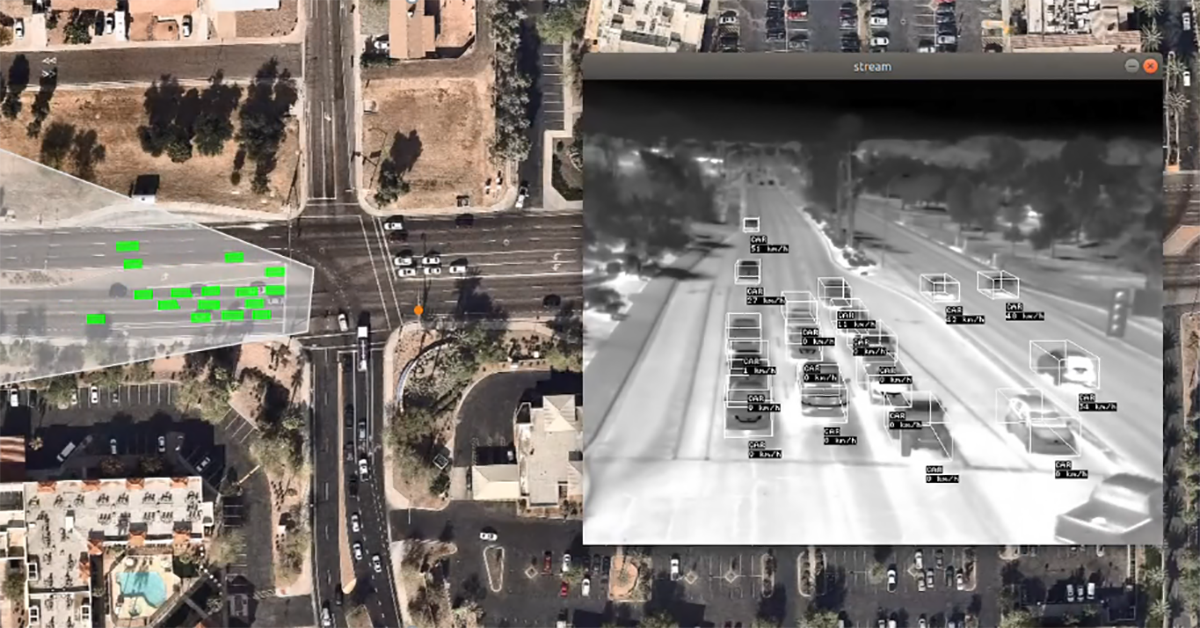FLIR-powered intelligent crossing leads to more safety for pedestrians
An innovative project at a busy retail park in the UK could provide the blueprint for a new approach to pedestrian safety. The system deployed at the Giltbrook site, near Nottingham,UK, uses flashing road studs and warning signs to create a visual warning for motorists approaching an internal pedestrian crossing, which spans the main vehicle access to the park. The LED studs and warning signs are activated by FLIR’s C-Walk pedestrian detector.
Pedestrians crossing the road get picked up by the FLIR C-Walk sensor, which will activate the road studs and slow down sign further up the road.
Managers at the Giltbrook retail park wanted to enhance drivers’ awareness of foot traffic and were looking for a technology that was dedicated to pedestrian detection only. They found that FLIR’s C-Walk pedestrian detection sensor was a perfect fit for the application. ITS system integrator Swarco came up with an intelligent solution based on FLIR’s C-Walk pedestrian detection. The behavior of drivers changed almost immediately and feedback has so far been really positive. The system is certainly doing a good job and, while this was the first of its kind in this country, it could be the start of a new approach.
Pedestrian detection
A pole-mounted C-Walk sensor detects pedestrians crossing the street in a predefined detection zone. Pedestrians entering that zone get picked up by the sensor and will activate the road studs and slow-down sign further up the road. FLIR’s C-Walk is an all-in-one sensor that integrates a detector and a camera in one unit. It make use of predefined detection zones (“virtual loops”) and provides reliable pedestrian detection on a 24/7 basis. Early indications show that the bespoke system is already persuading drivers to approach the crossing at lower speeds. The flashing studs only work when pedestrians are using the crossing, so drivers know from a fair distance away that they must slow down. People are sometimes not as alert as they should be if lights are flashing all the time, so the fact that the studs blink only when pedestrians are using the crossing creates an instant alert.
It’s a clever, practical, low-cost and sustainable way to increase safety and, though this is one of the first times studs have been used in this way, certainly in this country, it’s unlikely to be the last. The warning system is designed to improve pedestrian safety, but is not inhibitive to drivers - it simply reminds them they are off the public highway and provides a step change in the thought process. The studs are very effective in raising awareness of pedestrians or for applications where hazard warning or enhanced navigation is important. ”The C-Walk from FLIR Systems is really the centerpiece of the installation," says Sukhdev Bhogal, Business Development Director at FLIR Systems. "Take that away, and the whole system will definitely fail. The system looks particularly good when it’s dark and feedback has been very positive from both customers and tenants.”
Configuration of the FLIR C-Walk sensor is done via portable PCwith pre-installed user-friendly software.
Easy installation
C-Walk sensors have been designed to avoid expensive installation and maintenance costs. As such, the installation process is quick and simple: install it, connect it and start analyzing the pedestrian detection zone. The sensors can simply be mounted on existing infrastructure. Configuration of the sensor is done via portable PC with pre-installed user-friendly software. It takes less than five minutes and requires no specialist knowledge. Using camera images, virtual pedestrian detection zones can be positioned accurately. Verification and viewing of the detection is possible via MPEG-4 streaming video.
“The FLIR C-Walk sensor is very easy to set up,” says Sukhdev Bhogal. “The installation is pretty straightforward and the software environment is very intuitive. What works very well is that you can visually set up your detection zones on your laptop and verify whether the detection actually works.”


